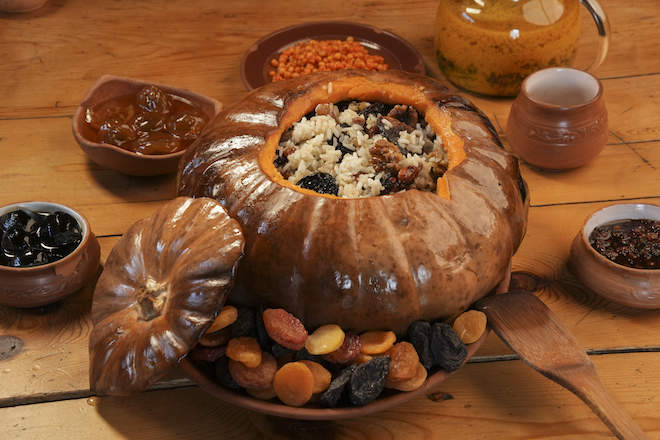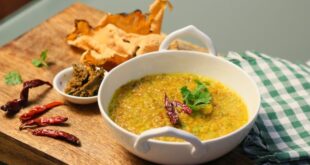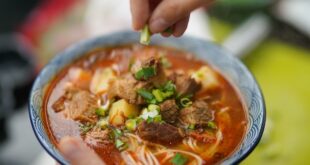Last Updated on December 4, 2023
Nestled at the crossroads of the Middle East, Eastern Mediterranean, and the Caucasus, Armenia beckons travelers with an invitation to explore its rich culinary heritage. Armenian cuisine, an integral part of the country’s identity, mirrors its diverse cultural influences, traditions, and geographical splendor, offering a gastronomic adventure that tantalizes the taste buds and nourishes the soul.
A Tapestry of Flavors

Armenian cuisine, steeped in history and tradition, presents an array of flavors that evoke the essence of the land. Rooted in centuries-old recipes designed for farmers and herders, these dishes celebrate the use of fresh ingredients and wild-grown herbs, providing both nutrition and cultural significance.
Traveling to Armenia unveils a world where the history of Armenian cuisine intertwines with everyday life. In the heart of Armenian kitchens stands the unique “tonir,” a traditional clay oven deeply embedded in the ground—an emblem of culinary tradition and heritage. Exclusively Armenian, these tonirs hold significant cultural value, with centuries-old traditions woven into their construction and use.
The tonir takes center stage for baking lavash, a notable and cherished bread that holds a special place in Armenian cuisine. This large, thin bread, recognized for its unique baking process inside the tonir, accompanies various dishes and serves as a staple on Armenian dining tables. Notably, this revered lavash holds a prestigious position on the UNESCO List of the Intangible Cultural Heritage of Humanity, recognizing its cultural significance and the artistry behind its preparation.
Among the delights baked in these distinctive tonirs is Khorovats—a culinary masterpiece synonymous with Armenian gatherings. This symphony of barbecued meats, skillfully marinated and grilled to perfection, harmonizes with an array of grilled vegetables and fresh herbs. Khorovats encapsulates not just flavors but the very essence of conviviality and communal celebration, becoming an essential part of Armenian culinary experiences.
Exploring Armenian Culinary Traditions
Dive into Tolma, a traditional Armenian dish where minced meat and rice are carefully wrapped in vine or cabbage leaves, echoing the craftsmanship and cultural significance of each bite. Embracing vegetarian or vegan preferences, Tolma also manifests in a meatless version—Pasuts Tolma—crafted with seasoned beans, chickpeas, or rice.
Armenian cuisine is a tapestry woven with iconic dishes like Tzvzhik, featuring veal liver and onions, or Kufta, a meat “soufflé” prepared in distinctive regional styles. The culinary voyage also unveils Ghapama, a pumpkin stuffed with a blend of rice, dried fruits, honey, and walnuts—an exquisite tribute to the region’s heritage.
Preserving Tradition: Culinary Treasures of Armenian Heritage
While preserving age-old techniques, Armenian culinary practices embrace innovation, offering a blend of slow-cooked wonders and contemporary tastes. Harisa, a slow-cooked porridge with chicken or lamb and cracked wheat, mirrors comfort in colder seasons, For the adventurous palate, delve into Khash, a thick bone broth made from unique ingredients like cow’s hoof and tripe, revered as Armenia’s winter delicacy and known as the ultimate hangover cure.
A Symphony of Vegan and Vegetarian Delights
Zhingyalov hats
Originating from the Armenian region of Artsakh, Zhingyalov hats epitomize the celebration of seasonal herbs. This flatbread marvel is a labor of love, boasting a delectable blend of up to 40 freshly harvested herbs, finely chopped and encased within thin layers of dough. The dough, rolled out thinly and stuffed generously with this herbaceous medley, is griddled to perfection. Each bite unfolds a symphony of flavors, where the fragrance and taste of the diverse herbs intertwine, creating a unique and refreshing culinary experience that reflects the vibrant essence of spring.
Ghapama

Ghapama, a culinary masterpiece with roots tracing back centuries, embodies the essence of Armenian vegetarian cuisine. This dish involves an intricate process where a pumpkin is meticulously hollowed out and stuffed with a sumptuous mixture of fragrant rice, dried fruits like apricots, prunes, and raisins, alongside flavorful nuts such as almonds or walnuts. The pumpkin serves as both a vessel and an infusion tool, imparting its sweet, earthy essence to the rice as it bakes to tender perfection. The amalgamation of these ingredients creates a harmonious blend of sweet and savory notes, celebrating the wholesomeness and ingenuity inherent in Armenian vegetarian gastronomy.
Wild-Grown Herb Soups and Salads
Armenian cuisine celebrates the use of wild-grown herbs, notably incorporating them into nourishing soups and invigorating salads. Sorrel, a tangy and refreshing herb, often finds its way into these culinary creations, lending its distinct lemony flavor. Whether as a key component in hearty soups or as a refreshing addition to vibrant salads, these wild-grown herbs add depth and character to the dishes, elevating them with their unique and vibrant taste profiles while connecting the cuisine to the rich bounty of Armenia’s natural landscapes.
Each of these dishes represents a fusion of tradition, innovation, and a deep-rooted connection to the land, showcasing the diverse and tantalizing flavors of Armenian vegan and vegetarian cuisine.
Sweet Epilogues and Culinary Festivals
The crescendo of an Armenian feast culminates in the realm of sweets. Indulge in gatas, a, or relish the sweetness of Baklavas,. Local markets like GUM in Yerevan offer a plethora of culinary delights—from cured meats to Ttu Lavash, savory fruit leather spreading flavors of Armenia’s vibrant culinary heritage.
Armenian cuisine beckons travelers to participate in culinary festivities like the Tolma, Gastro Festival in Dilijan and Khorovats festivals, where they can engage with locals and experiment with traditional dishes. Engage in agrotourism, attend Armenian cooking classes, and discover the delights of local markets, all while relishing the warmth of Armenian hospitality.
An Ode to Culinary Splendor
To travel to Armenia is to embark on a gastronomic journey—a pilgrimage through time, flavors, and traditions. Armenian cuisine transcends the mere act of eating; it is an immersive experience that connects travelers to the beating heart of a culture—a celebration of resilience, warmth, and the artistry of flavors. So, indulge, explore, and let the tastes of Armenia linger long after your journey concludes—a flavorful memoir of an unforgettable experience.
 Travel for Food Hub The Food Blog for Travel Lovers
Travel for Food Hub The Food Blog for Travel Lovers
















